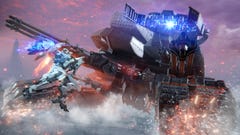Armored Core 6: Fires of Rubicon review - a triumphant return for the venerable mecha series
Brand Evangelionist.
Let's start by addressing the elephant in the room. Armored Core VI: Fires of Rubicon is not a Soulslike. From the moment the game was announced there's been, depending on your perspective, a concern, a hope or even an expectation, that the first new AC title in a decade would seek to emulate its critically and commercially acclaimed From Software stablemate. That's absolutely not the case. There's no intricately-designed interconnected levels here, no bonfire equivalents, no enemies that respawn when you rest.
In fact, AC6 is remarkably traditional in structure. While there are some branches in the narrative (three in my first play through, I believe) it's a largely linear mission structure spread across five chapters. Sometimes there will be more than one mission on offer but, unless it's one of the clearly marked decision points, they all need to be completed before progressing, it's just a case of which one to tackle first. With the exception of the separate PvP multiplayer modes, which weren't available at the time of review, the only distractions from the campaign are a 1v1 AI arena mode and the option to replay already completed missions.
The missions themselves tend to be quite short, with many of them lasting less than ten minutes, even for a cautious player. Checkpoints are generously positioned before bosses and tough encounters and it's very rare that you'll find yourself having to redo a tricky section multiple times.
Compared to the sort of multi-layered, twisty labyrinth of systems and storylines that has become From Software's stock in trade, it almost feels barebones. While I wasn't expecting a Mass Effect/Dragon Age or Fallout/Elder Scrolls situation, I was thinking that a little more Soulslike influence would have crept in and a small part of me was disappointed that it hadn't. Reader, that part of me was foolish and wrong. AC6 doesn't need Soulslike influences, because AC6 is hands down the best mech game I've ever played.
From the first moment you take the controls, piloting your mech feels fantastic. The titular ACs aren't the lumbering brutes of Battletech, instead they're pure Mobile Suit Gundam. Sure, they're armoured engines of war that are bigger than a house, but they're fast, unleashing torrents of laser fire while dodging a hailstorm of missiles. Sure, you can trudge along on foot (or occasionally tracks) but the vast majority of the time you'll be in boost mode with an array of thrusters blasting your AC across the map at high speeds, dodging, dashing and leaping through the air.
.jpg?width=690&quality=75&format=jpg&auto=webp)
.jpg?width=690&quality=75&format=jpg&auto=webp)
.jpg?width=690&quality=75&format=jpg&auto=webp)
.jpg?width=690&quality=75&format=jpg&auto=webp)
It's in mechanised movement that you begin to realise that, while not a Soulslike, AC6 is very much a From Software game. Sure, the team hasn't climbed into the cockpit in a while, but they have been perfecting their signature measured, thoughtful combat. With AC6, they're just slapping high-powered rocket boosters on everything and giving you four massive guns instead of your trusty sword. Thankfully, there's no need to learn the legendary Armored Core grip (a joke about the overcomplicated controls of some previous series entries that became a meme in Japan). The four shoulder buttons take care of the four weapon slots, while boosting, quick boosts (dodging) and jumping are on the face buttons. The game does slightly overspill the typical controller layout, with the Y/triangle button acting as a modifier for a couple of actions, like manual reloading, but it's not particularly onerous. My only real complaint here is that it felt far too easy to activate the forward charge boost manoeuvre with an accidental left stick click, but that may be the fault of my massive clumsy bear paws.
You'll likely spend first frenzied forays into fisticuffs leaning heavily on the vertical boost and pounding the dodge button with wild abandon, quickly depleting your energy bar and leaving yourself vulnerable to counterattack. With experience, however, comes mastery and you'll soon learn when you can just strafe out the way of laser beams and use your energy sparingly in order to prolong your air time. What was once panicked and desperate becomes balletic, as your AC smoothly weaves between rocket barrages and gracefully leaps artillery positions to deal damage from behind.
.jpg?width=690&quality=75&format=jpg&auto=webp)
As mentioned, there are four slots for equipping weapons to your AC, two arm mounts and two shoulder mounts. Generally speaking, your bread and butter weapons, rifles, shotguns, SMGs and the like, are hand-held, while missile pods and laser cannons are shoulder-mounted. The mounts on the left of your AC can also accept melee weapons and energy shields on the arm and shoulder, respectively. There's an impressive arsenal on display right from the start and it only gets more expansive and esoteric as the game progresses. I half expected Peter Serafinowicz to pop up and ask if I wanted my laser cannon in the standard or diffuse variety. Actually, that would have been great, can we have that as DLC? (And on the subject of John Wick and other Keanu Reeves-fronted action movie franchises, yes you absolutely can equip your AC with a pair of massive pistols and pay tribute to the cinematic works of John Woo. It's surprisingly effective!)
It's not just the weapons on your AC that can be customised to your liking. The mech itself is made up of head, torso, arm and leg sections, and three internal components. There's plenty of scope for customisation without being overly granular and fiddly. Balancing speed against survivability is the main concern, and beyond that you can adjust your build to favour your preferred playstyle in a multitude of ways, such as faster missile lock-on, or enhanced melee attacks. The single most impactful component is the legs, which come in four varieties. Bipedal legs are the standard, balanced option, while reverse joint legs are better at jumping, getting you higher in the air without using your precious energy reserves. Quadrupedal mechs are heavier, but have better carrying capacity and can adopt a hover mode for efficient airborne annihilation. They're also more stable, allowing you to fire heavy weapons on the move, a trait they share with wheeled and tracked frames. This turns your AC into a tank with a mecha upper body instead of a turret, and sacrifices agility in the air for sturdy stability and the ability to drift. Who needs to fly when you can drift a house-sized robot at high speeds while firing bazookas and grenade launchers?
.jpg?width=690&quality=75&format=jpg&auto=webp)
.jpg?width=690&quality=75&format=jpg&auto=webp)
.jpg?width=690&quality=75&format=jpg&auto=webp)
.jpg?width=690&quality=75&format=jpg&auto=webp)
There's a lot going on, and you'll probably spend as much time building your AC as you do piloting it, especially if you get deep into the incredibly detailed paint and decal customisation. Fortunately, AC6 encourages experimentation by allowing you to sell unwanted parts for the same price as you paid for them and the only maintenance costs come out of your mission rewards, so you can never find yourself backed into a financial corner. The clever twist is that you can swap out parts when you die and respawn mid-mission, but you can't access the store without restarting the whole thing. Acquiring an array of weapons and components allows you to quickly adjust your build when facing bosses, tweaking and refining things until you're happy that you've got the best gear for taking it on. If you realise you're missing a bit of kit that'd make your life a lot easier, you have the choice of persevering, or exiting the mission and doing a little shopping before restarting.
The balance between building and blasting is nigh-on perfect, turning each encounter into a puzzle that you solve by piecing together your ideal build. You'll gradually become more familiar with the parts on offer and what suits your particular play style and preferences. It's deep without being clunky, and Frankensteining together your ideal AC for every challenge is a joy. It keeps you hungry by never quite offering enough. Yes, the pilebunker makes for a righteous killing blow, but that means sacrificing firepower at range. You'll always wish you had space for one more weapon, or just a little more speed.
.jpg?width=690&quality=75&format=jpg&auto=webp)
If this all sounds a little overwhelming, don't worry, because AC6 manages to be one of the most approachable action games I've encountered in ages. You get dropped into the introductory mission, which teaches you the basics, with minimal fuss. Once you're into the game proper, you have virtual training missions available, but only one or two at a time and they're focussed on learning specific aspects of the game. It's neither tediously front-loaded nor patronisingly drawn-out, instead introducing new elements at a good pace over your first few hours, without giving the impression that you're being held back from the real game.
On the flipside, it's still bloody tough. In terms of my l33t g4m3r skillz0rz (sorry), I consider myself firmly average-to-decent and there were definitely a few bosses that had me plugging away for an hour or so. There are mission rankings for the hardest and corest, with an S-rank requiring swift completion with no retries and minimal damage and ammo expenditure. In a nice touch, you only get ranked on missions when you replay them, so you can enjoy a leisurely campaign playthrough without feeling judged. That said, at the risk of rehashing tired old arguments, I am disappointed by the lack of difficulty settings and accessibility features. The campaign is entirely single player and mission-based, so there's no reason not to have, at the very least, an easy mode. There's plenty on offer here for folks who want to test their skills to the limit, but anyone who finds themselves struggling (or has accessibility needs) is out of luck. With how user-friendly the game is otherwise, it feels weirdly dissonant.
.jpg?width=690&quality=75&format=jpg&auto=webp)
The weakest element of AC6 meanwhile is undoubtedly the storytelling. While the story itself is perfectly serviceable sci-fi guff with enough mystery to help gently lead you from one mission to the next, it's told entirely as conversation and exposition, either between or mid-mission. You don't even get to see any of the cast outside of their ACs, with only their personal emblems shown outside of missions. Between that and the fact that the game's (absolutely gorgeous) environments are frequently huge military or scientific installations, it can all feel a bit sterile and disconnected. It's hard to feel particularly strongly about the struggles of the Rubicon Liberation Front against the big, bad corporations when all you see is big robots and other military vehicles blasting the poop out of each other.
While AC6 is slightly lacking in narrative pizazz, that doesn't detract from the game as a whole. There's still enough meat on the storytelling bones to provide the genre-appropriate melodramatic moments. Finding yourself on the opposite side of the battlefield to a former comrade? Check. Horribly arrogant and self-important antagonists? Check. Beloved wingman swooping in to support your scene-stealing heroics? Check!
This is the scenery-chewing brilliance that the mecha genre's all about. I've had nothing less than a huge grin on my face the entire way through my silky-smooth, 30-odd hour campaign playthrough, because this is as good as it gets. With its uncanny ability to mix approachability with complexity, lean action with combat depth, Armored Core 6 sets the new standard for what mecha games can do.






.jpg?width=240&height=135&fit=crop&quality=80&format=jpg&auto=webp)


.jpg?width=240&height=135&fit=crop&quality=80&format=jpg&auto=webp)





